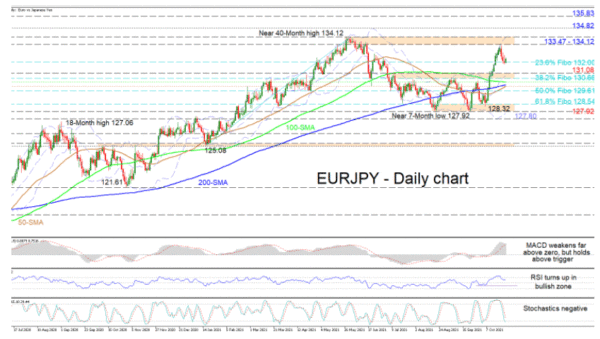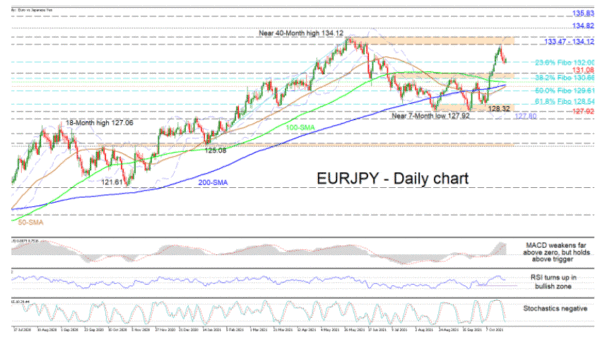EURJPY’s minor pullback is finding its feet at the 132.00 handle, that being the 23.6% Fibonacci retracement of the up leg from 125.08 until 134.12, after its latest rally that began at 128.32 lost steam just shy of the 133.47-134.12 resistance zone. A definitive trend is not being endorsed by the 50- and 100-day simple moving averages (SMAs), which are converging with the 200-day SMA.
The short-term oscillators are conveying mixed signals in directional impetus. The MACD and the stochastic oscillator are reflecting the price retreat in the pair and have yet to confirm any pickup in positive pressures, while the minor improvement in the RSI is signalling a growing buying interest.
If the positive forces intensify, initial upside limitations could stem from the resistance section shaped between the 133.47 fresh high and the near 40-month peak of 134.12. Conquering this and extending above the upper Bollinger band, the pair could hit the 134.82 border before buyers aim for the 135.83 high, achieved around the early part of February 2018.
Otherwise, if bearish powers return and drive the price beneath the 23.6% Fibo at 132.00, sellers could encounter a reinforced support area amongst the 131.08 inside swing high and the 38.2% Fibo of 130.66. If the price slips further, a nearby buffer zone from the 100-day SMA at 130.37 until the 50-day SMA at 130.01, and the looming 50.0% Fibo at 129.61 slightly lower could deter the decline from powering on. However, should the bears secure an advantage, they could then challenge the support base from the 61.8% Fibo of 128.54 until the near 7-month low of 127.92.
Summarizing, EURJPY appears to be regaining some buoyancy as it lifts off the 23.6% Fibo of 132.00. Should the price persist above the 130.66-131.08 barricade and the SMAs, the short-term picture may continue to exhibit a modest upside preference.



 Signal2forex.com - Best Forex robots and signals
Signal2forex.com - Best Forex robots and signals




